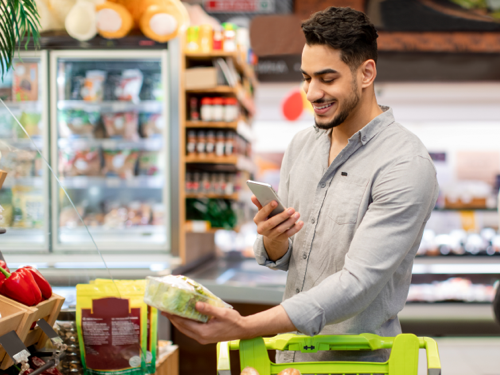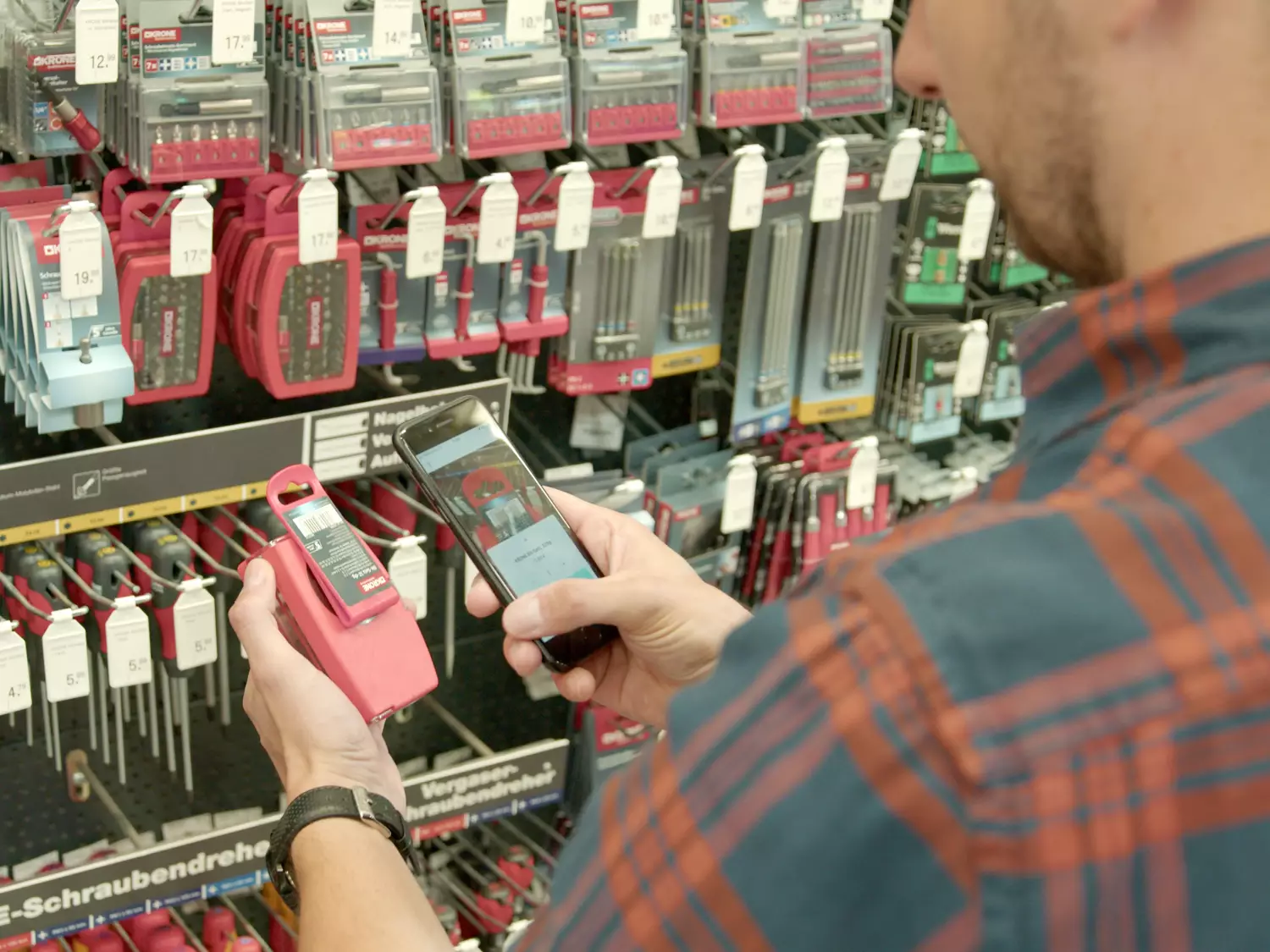Self-checkouts - Everything you need to know
Retailers are increasingly using self-checkout in their stores - find out why self-checkouts are becoming more and more popular with retailers and customers, how they work and what you should consider if you are planning to use self-service checkouts in your stores.
- The status quo - self-service checkouts
- Self-scanning, self-checkout and hybrid - possible applications and differences
- How does a self-service checkout work?
- Advantages of self-service checkouts
- Challenges with self-service checkouts
- Conclusion: Self-service checkouts in retail
The status quo - Self-service checkouts
The EHI Retail Institute recently published the EHI Market Survey 2023, revealing a significant increase in the acceptance of self-checkout systems in the German retail sector. This development is an indicator of the ongoing trend towards automation and increasing customer satisfaction in the retail sector.
Compared to 2021, the number of retail stores with stationary self-checkout systems has increased by 153% and the number of mobile self-scanning systems by 119%. The EHI survey documents that there are stationary self-checkout systems in 4,270 stores and self-scanning systems in 2,152 stores. In 1,400 stores, customers can choose between at least two self-checkout options.
The EHI Market Survey 2023 shows that self-service checkouts have experienced a rapid spread in Germany. Over 5,000 stores now offer the option of self-checkout, with options ranging from stationary scanning at the checkout to mobile scanning at the shelf.

Source: EHI handelsdaten.de
Rewe and Edeka groups lead the way with over 750 stores with self-checkouts. Rossmann, Obi, Netto, Penny, Kaufland and dm-drogeriemarkt follow with over 150 stores each. Around 60% of stores with stationary self-service checkouts are located in food retail, followed by 15% each in drugstores and DIY stores. In total, more than 16,000 self-service checkouts are in use, with food retail alone providing 9,600 checkouts. In food retail, stores with self-service checkouts account for around 7.5%, with an average of 3.7 checkouts per store. Despite the decline in cash payment options and the increase in card payments, 45% of grocery and DIY stores still offer self-service checkouts with a cash payment module.
Offers for mobile self-scanning have doubled in the last two years, although the technology is growing less strongly than stationary self-service checkouts.
The positive customer acceptance of self-checkout systems points to further growth. Self-checkout systems are particularly popular in the discount sector, which is why an increase is expected. However, with the increasing spread of SCO systems, the risk of theft or fraud is also growing, to which many companies are responding with technical aids such as exit gates, weight checks, video recordings in the checkout area and AI systems. These measures are aimed at minimizing the risk of theft, which in part inhibits the growth of this technology. To meet the challenges, retailers are increasingly turning to advanced technologies such as AI for product recognition and data analysis for plausibility checks.
Despite automation, qualified staff in SCO areas remain important to ensure efficiency and security. The survey predicts that the number of companies offering self-checkout will continue to rise, especially with the introduction of app-based solutions.
Self-scanning, self-checkout and hybrid - possible applications and differences
The world of retail has changed significantly with the introduction of self-scanning, self-checkout and hybrid systems. These technologies offer customers flexibility and efficiency in their shopping experience and enable retailers to optimize their operations. The various systems and their possible applications are described in detail below.
Self scanning
-
How it works: With self-scanning, customers scan their purchases in the supermarket, either with a handheld scanner provided by the store or with their own smartphone in hand. To use a smartphone, you need a specific app that enables the concept of self-scanning. These devices allow customers to scan items while shopping and place them in their shopping cart or bag.
-
Where it is used: This technology is mainly found in supermarkets. Large chains such as Rewe and Globus offer hand scanners, while Edeka groups such as Edeka-Minden use the "Easy Shopper" or the "Scanbox".
-
Advantages: Self-scanning speeds up the payment process, as customers can enter their items while shopping and proceed directly to payment. It also reduces waiting times at traditional checkouts.

Self Checkout
-
How it works: Self-checkout registers are part of a modern POS landscape, they are cash registers where customers scan and pay for their purchases themselves after collecting them at a terminal. These checkouts are equipped with barcode scanners, touchscreens and payment modules.
-
Where it is used: They are widely used in a variety of sectors, including food, drugstores and DIY stores. Rewe, Edeka and other large chains have widely implemented these systems.
-
Advantages: They offer customers a fast checkout process and reduce the need for large checkout staff. These checkouts are particularly advantageous at peak times to minimize waiting times and make work easier for staff.

Hybrid systems
-
How they work: Hybrid systems combine elements of self-scanning and self-checkout. They offer customers the choice of either scanning items while shopping in-store or scanning them at a self-checkout.
-
Where it is used: Some stores offer both options to suit different customer preferences. Examples include Globus Markthallen, Kaufland and Rewe stores, where customers can choose between handheld scanners, smartphone apps and stationary SCO checkouts.
-
Advantages: Hybrid systems maximize flexibility and choice for the customer. They offer a personalized shopping experience by allowing customers to choose the most convenient option for them depending on their preference and situation.
Self-scanning, self-checkout and hybrid systems represent different facets of modern shopping technology. All of them represent an extended customer service alongside the traditional checkout. Even 24/7 formats, which means stores where customers can shop around all hours of the day, are now possible. While self-scanning allows customers to scan products while shopping and thus save time at the checkout, self-checkout systems offer a complete, autonomous checkout solution at the end of the shopping process. Hybrid systems combine the advantages of both approaches and thus offer maximum flexibility.
These technologies are not only efficiency-enhancing and customer-friendly, but also an indicator of the ongoing digitalization and automation in retail. They help to improve the customer experience, reduce waiting times and optimize operations. Despite the challenges associated with implementing these systems, their increasing prevalence is a clear sign of their effectiveness and popularity with customers and retailers alike.
How does a self-service checkout work?
.jpg?width=1403&height=934&name=person-paying-with-its-smartphone-wallet-app(2).jpg)
Self-service checkouts, often referred to as self-checkouts, have become an integral part of the modern shopping experience. This technology offers customers the opportunity to complete their purchase quickly and independently, increasing efficiency and reducing waiting times. Self-checkouts generally work as follows:
-
Item selection and scanning: The first step in using a self-service checkout is for the customer to scan all selected items themselves. Each item has a barcode that contains the product information. The customer passes this barcode over a scanner, which reads the information and registers the item. With some systems, it is also possible to manually select items via a touchscreen if the barcode is damaged or unreadable.
-
Payment process: Once all items have been scanned, the customer selects a payment method. Self-service checkouts usually offer various options, including cash, card and contactless payment. The customer completes the payment and follows the instructions on the screen.
- Receipt and completion: Once the payment has been completed, the checkout prints out a receipt for the customer to take with them. The customer is then asked to leave the checkout area so that the next customer can use the checkout.
- (Optional) Weight check: Many self-service checkouts are equipped with a scale that checks the weight of the scanned products. This serves as an additional security measure to ensure that all items have been scanned correctly.
Furthermore, a self-service checkout can have additional functions that improve the customer experience and increase security during self-checkout. In the event of problems or questions, there is usually a "help" button that notifies employees and prompts them for support and assistance. Some systems also offer video support or interactive help. By integrating loyalty cards and discount promotions, customers can scan their loyalty cards or enter discount codes to benefit from offers and discounts.
Self-service checkouts therefore simplify the shopping process considerably and offer numerous benefits to both customers and retailers. They are a prime example of how technological progress can make everyday life easier and retail more efficient. As they become more widespread and continue to evolve, they are making a significant contribution to modernizing the shopping experience.
Advantages of self-service checkouts
Self-service checkouts, also known as self-checkouts, have become an integral part of today's retail sector. Their ease of use offers numerous advantages that are important for both customers and retailers. This chapter highlights the key benefits of this innovative technology.

Customer benefits
- Reduced waiting times
- Increased self-determination
- User friendliness
From the customer's perspective, self-service checkouts primarily offer time savings and efficiency - waiting times can be reduced and a faster throughput guaranteed. Instead of having to wait in long queues, they can complete their purchases faster and more efficiently at a terminal, which has a positive impact on the customer experience. As several self-service checkouts can be used in parallel instead of one traditional checkout, the throughput is accelerated, which can make a big difference, especially at peak times. Customers today place more value on autonomy and self-determination, including in the checkout process. Self-service checkouts offer customers more control over the entire checkout process thanks to independent operation. They can scan and rescan goods and products at their own pace and, if necessary, check the final total before paying. Modern self-service checkouts also focus on user-friendliness. They are user-friendly and intuitive to operate and offer clear instructions and support, making the process easy even for less tech-savvy customers.

Retailer benefits
– optimization of the cost structure
- Increased customer loyalty
- Extended service functions
There are also important opportunities for companies through the use of self-checkouts. The compact design of a self-checkout allows retailers to make better use of the space available in the store and therefore optimize the store layout. At the same time, they can minimize the risk of abandoned purchases due to long waiting times. It also opens up new possibilities for planning staff resources, e.g. by relieving staff at peak times and thus taking a considerable amount of work off their hands. Furthermore, retailers can increase customer loyalty, e.g. by integrating customer cards and loyalty programs. The self-checkout process can be expanded to include a personalized shopping experience, from redeeming a voucher to using special promotions for targeted sales promotion. Increased customer satisfaction can also lead to repeat purchases.
Overall, self-service checkouts offer a wide range of benefits that simplify the shopping process for customers and increase operational efficiency for retailers. The technology represents the ongoing trend towards digitalization and automation in retail and plays an important role in shaping the future shopping experience.
Challenges with self-service checkouts
Self-service checkouts are highly complex technologies and therefore potentially prone to disruption. Retailers should therefore choose technology partners that rely on scalable and reliable structures. In addition, the initial investment costs are often underestimated. Retail companies should be aware that, on the one hand, self-service checkouts are complex IT solutions that require interfaces to other systems, such as the ERP system, and, on the other hand, the corresponding hardware, i.e. the "cash register", must be procured in order to equip stores with it and use the software on it.

When using self-service checkouts, retailers should be aware that customers may not be familiar with the technology at first and offer appropriate support to achieve a high usage rate. User errors can lead to delays, which can slow down the checkout process for other customers. Accordingly, customers should be supported as needed to break down barriers and familiarize them with the scanning and payment process. Employees should therefore be trained to deal with user errors. Finally, the use of self-service checkouts can lead to a shift in shoplifting. In this case, shoplifting shifts from the store floor to the checkout process. This can be counteracted by using supporting technology. A blog post that deals with the topic of theft prevention in brick-and-mortar retail in more detail is linked at the end of this page.
In summary, there are a number of challenges that companies should be aware of. The increase in stores with self-service checkouts (as of 2023: 117% more than 2021) suggests that the benefits for retailers outweigh the challenges - especially as solutions already exist for these fields.
Conclusion: Self-service checkouts in retail
.jpg?width=1285&height=855&name=person-paying-with-its-smartphone-wallet-app(3).jpg)
Self-service checkouts are experiencing strong growth in Germany, particularly in food retail, with a variety of forms such as self-scanning, self-checkout and hybrid systems. They increase efficiency and customer satisfaction, offer flexible payment options and improve the shopping experience. Challenges include technical reliability, initial investment costs, user acceptance and security against theft. The continuing spread shows the conviction of retailers and the confidence of companies in this technology, supported by advanced solutions such as artificial intelligence.
Share this
You may also like
These related stories

The five most common challenges when implementing self-scanning systems

Scan & Go In Hardware Stores
